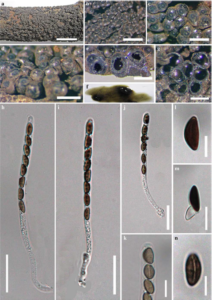Annulohypoxylon stygium (Lév.) Y.M. Ju et al. Mycologia 97(4): 861 (2005)
Index Fungorum number: IF 500326; Facesoffungi number: FoF 000298
Isotype – K 42247
Saprobic on decorticated wood. Sexual morph Ascostromata 1–10 × 0.5–3 × 0.04–0.1 cm (x̄ = 6 × 1.8 × 0.08 cm), pulvinate to effuse-pulvinate, with conspicuous perithecial mounds, surface shiny blackish, with reddish brown tone, dull reddish brown granules immediately beneath surface and between perithecia, with KOH-extractable pigments greenish-olivaceous (90) or dull green (70), the tissue below the perithecial layer inconspicuous, perithecia obovoid, 0.2–0.3 × 0.3–0.5 mm (x̄ = 0.3 × 0.4 mm), ostioles papillate, encircled with a convex truncatum-type disc 0.1–0.2 mm diam. (x̄ = 0.15 mm). Asci (48–)55–90(–97) × (2.8–)3–4(–4.7) μm (x̄ = 73 × 3.7 μm, n = 20), 8-spored, unitunicate, cylindrical, pedicellate, apical ring bluing in Melzer’s reagent, discoid, 0.5 × 1 μm (x̄ = 0.3 × 0.4 μm, n = 20). Ascospores (5.3–)6–10.5(–10.9) × (2.4–)3–5.5(–5.8) μm (x̄ =8.3 × 4.4 μm, n = 30), uniseriate, one-celled, ellipsoid-inequilateral, with narrowly rounded ends, light brown, with straight germ slit spore length on flattened side, perispore dehiscent in 10 % KOH, smooth, epispore smooth. Asexual morph Undetermined.
Culture characters – Colonies on OA at 25–28 °C reaching 5 cm in 7 days, from above, at first whitish developing hazel (88) shade in the middle after 5–7 days with the time the hazel shade spreads over the entire plate, azonate with diffuse margins, reverse at first citrine greenish-olivaceous (90) and developing black patches in the centre after 5 days, azonate.
Material examined – SRI LANKA, 1915, T. Petch 4465 (K42247, isotype), THAILAND, Chiang Mai, Doi Inthanon National Park on decaying wood, 3 December 2012, D.A. Daranagama and K.D. Hyde, AXL 034 (MFLU 13–0109), living cultures, MFLUCC 12–0826.
GenBank Accession numbers – ITS: KJ940870; LSU: KJ940869; RPB2: KJ940868.
Notes – Annulohypoxylon stygium, A. nitens and A. truncatum were possible species to accommodate this specimen regarding the stromatal characters. In the latter two species, the asci possess longer stipes, whereas in this specimen, the stipe is short. Annulohypoxylon nitens has KOH extractable greenish-olivaceous pigments, whereas in the studiedspecimen, the pigment is more towards green series. In this specimen, there are more conspicuous, glomerate, perithecial mounds, in contrast to the description given by Ju and Rogers (1996). The majority of the sequences deposited in the GenBank are ITS and a few reliable sequences for β-tubulin. In this study, we provide new LSU and RPB2 sequences from an authentic strain.

Fig. 1 Annulohypoxylon stygium (MFLU 13–0109) a Stromatal habit in wood b, c Ostioles seen from above d Stroma in side view e Cross section of the stroma showing perithecia f Pigment formation in KOH g Perithecia from above h-j Mature ascus in water k Ascus in Melzer’s reagent showing weakly stained inconspicuous amyloid ascal apical apparatus l Ascospore in water m Dehiscent perispore in KOH n Ascospore showing germ slit. Scale bars: a=1 cm, b-g=0.5 mm, h–n=10μm.
